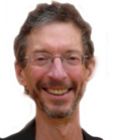Environment
Waking Up (Unexpectedly) In Ecuador, Part 1
Blue-footed boobies, unconscious climate denial, and hope for our future.
Posted June 6, 2019
“The climate crisis is the issue that most keeps me up at night; I can hardly bear to even think about it. Sometimes I think all of us should drop everything else we're doing and just focus on this.”
— Email from a friend
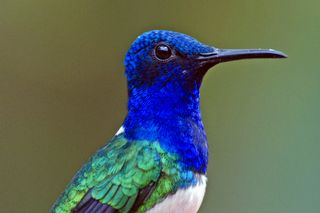
Introduction:
Like my sleepless friend, I worry a lot about what is happening to our planet Earth. And a recent trip to Ecuador and the Galapagos Islands brought home to me in a very personal and visceral way how insulated I am from the climate and from nature, as are so many of us in the U.S. I came home hopeful, and more awake than I had been.
So in what follows—a three-part series of posts on this blog—I want to share what happened on that trip and how I came to understand more about what actions I need to take to feel less overwhelmed and helpless about our climate crisis. I welcome comments and feedback from readers, including any thoughts about your own experiences living through the climate emergency that is planet Earth in 2019.
Part 1: In the Andean Cloud Forest with Santiago, Lucia, and Tom
When the time came to leave for our trip to the Ecuadoran cloud forest and the Galapagos Islands, I was feeling gloomy.
In New Hampshire, where I spend the bulk of my time, the 2020 Presidential primary was heating up and the candidates were arguing about every issue except the most vital: what is happening to our climate and the environment we take for granted? The Green New Deal was getting hammered by climate skeptics before its quite practical and very do-able ideas had even been debated and understood.
I had recently published an op-ed in our local paper urging our resistant, climate—denying our governor and our hesitant legislature—and voters—to make more active efforts to deal with what I suggested we now refer to as a “climate crisis,” rather than the more neutral term, “climate change.” The piece was met with some applause, some hostile comments, a lot of silence, and the email above from a friend. I can hardly bear to even think about it.
Amen to that, though the “dropping everything” I was doing involved heading out of town with my wife for a two-week vacation to sunny, warmer, South American climates.
Our flights to Quito from Boston via Miami had been rearranged and then delayed by the grounding of the 737 Max 8s so that we arrived at 1 a.m. after a full day of travel and hurry-up-and-wait moments at airports. We were only going, I groused to my wife, because friends of ours had returned from the same trip to Ecuador and the Galapagos and said, “you have to go; it’s unbelievable.”
Quito is the second highest capital in the world, at 9,300 feet, and altitude headaches greeted us soon after arrival, giving further fuel to my conviction that we’d become hostages to our friends’ excessive enthusiasm for their trip. Why not just go to a Caribbean island and sit in the sun? At sea level?
A day relaxing—and adapting to the altitude—outside Quito at La Jimenita, a local hacienda and bird preserve, took care of the headaches and we were soon off to the Mindo-Nambillo cloud forest on the Western slopes of the Andes, about two hours northwest of the capital.
We were accompanied by our friendly and very knowledgeable 40-something naturalist guide, Santiago, one of three guides we met on our trip who each, in different ways, took pleasure in the natural world and who wanted to share it with us. Their pleasure was infectious, as was their concern for what was happening to that world around them. A retrograde mystical side of me—“retrograde” given what I am about to tell you about the struggle between science and religion for our understanding of life on this earth—feels in retrospect that these three guides, two men and a young woman, appeared at just this moment in my life to wake me up.
*
Maybe there are transformative people and places that come to you just when you are ready.
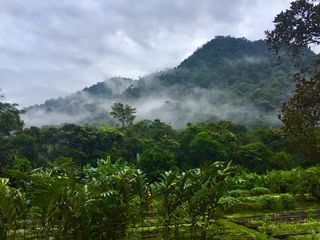
As we drove past primal forests, Santiago was more than happy to answer our questions and describe to us the way that the volcanic activity over millions of years has shaped the spectacular geology of the Andes, which in turn has shaped the wildlife that inhabit it. Toucan barbets, tanagers, quetzals, glass frogs, antipittas, the Andean cock-of-the-rock, and, of course, hummingbirds.
I am not a “birder.” For a large swath of my life, there were only two kinds of birds in my world: brown birds and all the others. Oh, and pigeons. (I grew up outside New York City .) So you can imagine what it was like to see the explosion of color at the two hummingbird refuges we visited on the way to Mindo. Bursts of red, yellow, orange, violet, purple, clustered around feeders like winged firecrackers. Dozens of varieties of hummingbirds, some with long beaks, some with short beaks, others with curved beaks like tiny Turkish scimitars.
We learned that there are species of hummingbirds in the cloud forest different from those found only a few hundred feet lower in the rainforest of the Andes. Such abundant life.
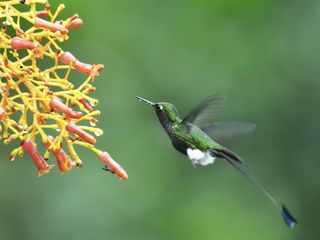
We have hummingbirds in New Hampshire, of course, but not like the cloud forest. In New Hampshire you would say (usually excitedly), “there’s a hummingbird at the feeder.” In Ecuador it’s, “which kind of hummingbird?” A White-necked Jacobin or a Purple-throated Woodstar? The area bursts with evidence of natural selection—there are hummingbirds with beaks adapted not only for altitude but for specific species of orchids. (The Ecuadoran cloud forest is home to the world’s largest variety of orchids.) The diversity of life is staggering and humbling, as was Santiago’s enthusiasm for identifying what we saw, even after decades of visiting these same hummingbird refuges. “Look, over there—a violet-tailed sylph! And don’t miss the buff-tailed coronet next to it!”
The number and variety of the birds—and his mastery in identifying what we were seeing—was such that sometimes we joked, "is he making up the names? (He wasn’t: we bought a guidebook to birds of Ecuador.)
There I was, on just our second day in Ecuador, looking at these beautiful birds and seeing through them the much bigger picture of climate change and its impact on life on this Earth. And, in turn, unknowingly, I was being transformed.
When you find yourself immersed in the beauty of the world during these perilous times, the sight can spark a desire to protect it. So much seems so fragile. Our appreciation of the beauty on the drive to Mindo that day was interwoven with concern for the precariousness and vulnerability of what we were seeing. We learned from Santiago that the Amazon basin—currently the largest rain forest in the world—is losing .89 percent of its forest cover per year. “In 100 years, it’ll be gone,” Santiago observed, gesturing out the window, “and so will we.” The “we” referred to the human species.
One major culprit is oil exploration in the Amazon basin, which creates water pollution from explosions attendant to sonic explorations for oil reserves, as well as from “oil dumping” practices that go back decades. Pristine ecosystems and indigenous people are suffering greatly as American oil companies move in and radically transform entire ways of life and geographies, resulting in significant health issues, social dysfunction, and environmental degradation that will ultimately affect us all.
Between stops to admire blue-winged mountain tanagers and rufous- throated hummingbirds, the three of us discussed the worldwide problem of plastics, derived from the petrochemicals being taken from the Amazon basin. Plastic cannot biodegrade—ever; it just breaks down into smaller and smaller particles, which gets into our groundwater, the food chain, and even our own bodies. The world is being suffocated by plastics, particularly single-use plastics. Many cities are banning plastic bags, but this is just the start—the bigger problem is single-use plastics that wrap so much of the stuff we buy.
Santiago told us about a grassroots protest in Chile, where shoppers took off the plastic wrappers for foodstuffs, candies, and other items at the check-out counter, giving them back to the cashier. “Things are overpackaged in general: why does toothpaste in a sealed tube also come packaged in a cardboard box?” I imagined holding up the line at our local supermarket, unwrapping all the packaging and giving it back to the stunned cashier. If they can do it in Chile, could we do the same in America? Raise awareness, have an effect?
“We also need to get rid of straws,” Santiago advised, whether plastic or paper. He taught us to say, “sin pajita, por favor.” Without a straw, please. The key is reducing consumption, not recycling.
Oil drilling in the Amazon leads to plastic consumption in the U.S. and elsewhere. Or maybe it’s the other way around: our hunger for plastic and its seeming convenience leads to oil exploration and damage to the Amazon ecosystem. Either way, it’s a dirty example of the reality of our Earthly interdependence.
Santiago, who came across as a kind of “realistic optimist,” offered a more positive example: did we know that enormous clouds of dust from the African Sahara drift across the Atlantic and feed phosphorus to the Amazon, nourishing the health of the rain forest? “We are all interconnected. Look it up—you can see it via NASA photos from space.” (We did, the photos are amazing, and he was right.) And the Amazon returns the favor to the African Sahara in regulating the temperature of the earth by absorbing heat.
Appeals to “the interdependence of life” have become almost a platitude, yet here in this astounding landscape amidst the pulsating varieties of life, the phrase took on new meaning for me.
As we pulled into Mindo, Santiago reminded us of what’s at stake in the struggle to preserve the beauty and vitality of all the plant, bird, and animal species we had just admired along the way: “Nature does not need people, but people need nature.”
There’s a limit to interdependence: we are dependent on the natural world we have evolved in. If the human species disappears, nature will just chug on evolving in its spectacular fashion.
*

You reach El Monte lodge in the cloud forest by crossing the Mindo river in a hand- pulled cable car, more like a “cable seat,” a few feet above the rushing white water. Which seemed an appropriate metaphor for crossing into a new and different sort of space than the “developed” world we were leaving behind for a time, a space where the “inside-outside” boundary disappears.
We were greeted by Tom, the co-founder of the lodge along with his Ecuadoran wife, Mariela. Tom grew up in a conservative Mississippi family and after several disappointing years teaching marine biology in a Gulfport High School (“the kids there thought marine biology was about joining the military. The advice I got upon arriving to teach was: ‘don’t smile till Christmas’”), Tom moved to the Amazon basin where he worked as a guide before starting his “eco-friendly” lodge more than 20 years ago.
I had always thought of “eco-tourism” as simply a high-end vacation in an unspoiled place that relieved wealthy tourists of their guilty consciences. While it may be that in part, what I learned at El Monte convinces me that ecotourism can be much more, and may offer a way out of the damage we are doing to our planet.
El Monte had all the accouterments of ecotourism: micro hydroelectric to provide electricity, gravity fed spring water system, farm to table gardening, low impact everything, but what most stood out for me was less the physical attributes than the psychological awareness that El Monte was trying to cultivate, that were reflected in the architecture and setting.
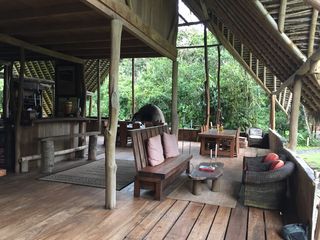
The main lodge itself is open air, with six cabanas discreetly placed out of view in the forest around the property. In the main lodge, artificial lights are limited to a few small lamps placed around the sitting and dining areas. As the twilight gathers (about 6 p.m. year-round—Mindo sits almost atop the equator), you become aware of the transition from daytime to nighttime. Since the lodge is open air, the night gathers around you—the growing darkness, the night air, the sounds of nocturnal animals stirring.
Tom explained that the absence of electric light cuts down on light pollution that affects the navigation of birds. It allows the eyes to adapt to the darkness and to see what is outside the lodge. And, it cuts down on insects finding their way into the lodge itself. Dinner took place over candles around a single large table that emphasized conversation. During one of those conversations we learned about Tom and Mariela’s efforts to support eco-tourism among the indigenous Waorani people of the Amazon, as an economic alternative to exploitation by the oil and gas industries. (The Waorani are currently suing the Ecuadoran government to halt petrochemical exploration of their lands.)
Ecotourism offers economic opportunity that replaces pillaging of the environment for indigenous people and it builds awareness for the consumers who use it. Speaking crudely, we might say that the incentive in eco-tourism for both the provider and the consumer is to conserve and protect what is being sustainably sold: the wildness and beauty of our planet. If it protects what we are losing, that works for me.
There was no TV anywhere at El Monte. Wifi is restricted to a small zone outside the dining hall—purposely, to make it easier for people to let go of their cell phones and look up at what is around them: the high tree-capped mountains surrounding the lodge, the astonishing variety of epiphytes (orchids and bromeliads) dangling everywhere off the trees, the toucans preening and feeding in the branches, the woodcreepers skulking around the grounds and, if really lucky, the occasional puma. Maybe even the Andean spectacled bear.
For many Ecuadorans we met, it seemed that the boundary between being “inside” and being “outside” was quite permeable. One morning, in the midst of an animated breakfast conversation involving my wife, Tom, myself, and Lucia, our energetic, very fit 24-year-old naturalist guide, Lucia suddenly stood up and turned to look deep into the forest behind her. “There are Toucans out there,” she whispered, reaching for her ever-present binoculars. The three gringos stopped their chatter. Where? Lucia was up staring through her binoculars, pointing to several of the multicolored birds with their outlandish beaks just past the first stand of trees outside the lodge.
Breakfast stopped for an extended opportunity to watch the fantastic birds eat and preen and use their beaks like giant pliers or serving tongs to find and break nuts and seeds. Finally, one of us asked Lucia, how did you know they were there?
“I listened.”
Oh. A question formed in my mind: how well do I listen to the natural world around me? As someone who lives much of the time two miles down a dirt road in rural New Hampshire, this was a sobering inquiry. I’d always presumed that I paid a great deal of attention to the life of the forests and fields around our house. Yet Lucia was listening to and hearing much more of the world than the rest of us at the table.
I wondered what it would be like to more fully acknowledge the natural environment that always surrounds me. And not just acknowledge it, but to feel truly a part of it. Could that be possible? This was a confusing question: I know I am a part of it, but what part exactly? Where do humans fit in? After all, the Bible tells us that God kind of builds up to the finale on the sixth day of creation and even tells us to “subdue” the earth and its other creatures. So, is my part to be at the top of the food chain? Do humans fit in as the overlords of the Earth? Am I, like centuries of explorers before me, just another master of a world that was created to satisfy human desire and need? Is that how I fit in?
*
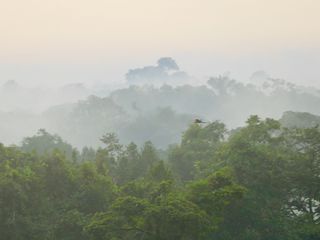
Lucia’s English was not as advanced as Santiago’s, but language hardly mattered: she communicated so much through the obvious pleasure she took in the world around her. Spotting several crimson-rumped toucans in the trees as we hiked, she stopped and did a little jig of delight as she exclaimed, “Sam, Julie, look up there!” When a friend of hers then came walking along the road, Lucia called her over to join in the bird-watching, which the woman did, as enchanted as the visitors. Often Lucia would take our arms to literally point us in the right direction to see whatever marvel she’d spotted. After several days hiking in the mountains around El Monte, watching Lucia’s deep appreciation for the world around her, the question became more urgent: how insulated from nature am I in my everyday life in the USA, how much are we all in our supposed “developed” countries? Do we not even see what is around us?
An odd thought perhaps for someone from “Live Free or Die” New Hampshire, where we pride ourselves on our seemingly abundant forests and many, seemingly pristine, lakes. Since my wife and I divide our time each week between rural New Hampshire and urban Cambridge, Massachusetts, we are not strangers to life “in the country” or “in the city.” And though we have done our share of camping, though we treasure the trails through our woods, though we take time to watch the hawks and loons and owls and bobcats and bears and deer—and hummingbirds—when our paths intersect, though even in the city we walk daily in a nearby park or along the river, still, the rhythm of the day at El Monte evoked a new feeling: a felt awareness of the breathtaking beauty and richness of what is all around me.
*
A question tagged along behind this felt awareness: how insulated from the natural world are we in this hip, digital age, with our heads buried in our smartphones?
It was not just Lucia and El Monte. Ecotourism seems to have preserved in all the Ecuadoreans we met a keener set of eyes and ears with which they observe their world. On the way back to Quito from the cloud forest, while zipping speedily along a forested highway, our driver casually observed, “that was a choco Toucan.” Where? When? “Back there. We just passed it.” We’d not seen what was in front of our eyes. On a walk along a quiet road alongside the Mindo river, I was determined to use my eyes and ears. I heard a deep, repetitive sound and I looked up quickly so as not to miss, this time, whatever amazing bird was nearby. “Uh, Sam, that was a horned frog.” Lucia pointed me toward a riverside puddle. Look down, not just up.
So, how insulated from nature am I? Is there a kind of woke-ness that happens, a way of stirring from sleeping through what is all around me—a way of awakening to what is at stake?
I certainly wasn’t entirely asleep: I’d written op-eds about the climate crisis, I’d protested the attacks on the EPA and other environmental regulations, I’d donated to environmental groups. Yet I’d been half- asleep, careless and distracted: how much of the world I so care about do I see as I go about my life? The rugged bark of a tree, on which is written the history of its life on this earth. The flashing miracle that is a golden finch. The springtime unfolding of the fiddlehead ferns returning from their winter slumbers. Can I link my visceral sense of wonder as I live in the world with my wish to protect it?
Most of us are perhaps not only climate- deniers trying to fend off our deep anxieties about what is happening to our world but also unconscious nature-deniers: sleepwalking (or sleep running) through what is all around us; not understanding how we are embedded in and dependent on the world in which we live.
Next: Part 2, In the Galapagos With Darwin and Diego



